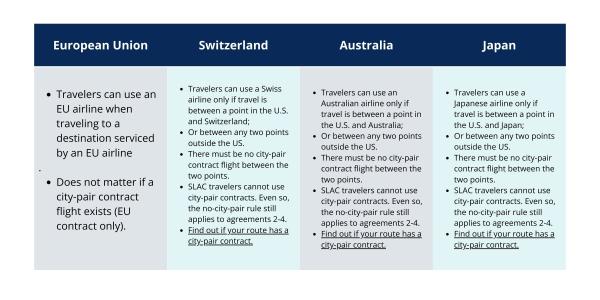Fly America Act and Open Skies Agreement
Fly America Act
Generally, if a traveler is traveling on funds provided by the federal government, he/she must use a U.S. flag air carrier. If there is no U.S. carrier to your destination, you must travel on a U.S. carrier as far as possible. By law, lower cost or personal convenience are not acceptable criteria for justifying the non-availability of a U.S. flag carrier. Please note that the same rules apply to foreign visitors' flights.
For a visual representation of the Fly America Act please view the following flowchart.
U.S. Flag Air Carriers and Code Share Alliances
Travelers must ensure that all flights, where possible, are scheduled on:
- U.S. flag carriers; or
- Foreign air carriers that code share with a U.S. flag carrier.
These U.S. carriers and their foreign codeshare partners travel to major cities in Europe, Asia, Africa, Australia, and South America:
- Alaska Airlines (AS)
- American Airlines (AA)
- United Airlines (UA)
- US Airways (US)
- Delta Airlines (DL) (Delta also has flights to Polynesia, check availability)
All airlines are obligated to inform the traveler of codeshare flights. Additional information on airline code share alliances is available on:
- StarAlliance.com with 21 partners including UA/US
- Oneworld.com with 10 partners including AA
- SkyTeam.com with 11 partners including DL/NW/CO
Reminder: A codeshare flight must be documented with the U.S. flag carrier airline code.
Below is the list of approved U.S. flag air carriers:
- Airtran Airways (FL)
- Alaska Airlines (AS)
- America West Airlines (HP)
- American Airlines (AA)
- American Trans Air (TZ)
- Delta Airlines (DL)
- Frontier Airlines (F9)
- Hawaiian Airlines (HA)
- Jet Blue (B6)
- Midwest Express (YX)
- Southwest Airlines (WN)
- Spirit Airlines (NK)
- United Airlines (UA)
- US Airways (US)
- Virgin America (VX)
Reminder: Air Canada is NOT a U.S. flag air carrier.
- United Corporate Direct is SLAC's recommendation when booking Fly America Act-compliant tickets; it is recommended for travelers due to its Stanford-negotiated rates and built-in Crisis24 feed.
- Visit our Booking Channels page for more information on using United Corporate Direct.
There are strictly limited circumstances in which an exception to the Fly America Act may apply and the use of a foreign carrier is allowable. For example:
- Airfare is not funded by U.S. federal funds
- Open skies agreement (see below)
- Other exceptions as listed in the Fly America Act Waiver Checklist
Open Skies Agreement
One significant exemption to the Fly America Act is the Open Skies Agreement. The U.S. General Services Administration published the United States and European Union (EU) "Open Skies" Air Transport Agreement on October 6, 2010.
This comprehensive document outlines the multilateral agreement, allowing eligible travelers supported by federal funds to fly on European Union airlines in addition to U.S. Flag Air Carriers. Similar Open Skies agreements exist with Australia, Switzerland, and Japan. In October 2011, the Department of Energy (DOE) granted SLAC authorization to utilize the Open Skies Agreement.
Please note: A Swiss carrier (i.e. Swiss Airlines) can only be used if the trip is directly to Switzerland. A Swiss carrier cannot be used if the final destination is not Switzerland. Trips to Australia and Japan also follow similar guidelines (see below). Switzerland, Australia, and Japan require a second condition that there must be no city-pair contract flight between the two points (see below).

If the above criteria are met, your itinerary may meet the open skies exception. Please fill in the Fly America Act waiver checklist and submit it with your expense report.
Email the Travel Office before you book your flight, if you are unsure that the itinerary qualifies as an Open Skies exception.
Airline Options
- Air Berlin
- Air France
- Lufthansa
- Iberia
- ITA Airways
- KLM
- LOT Polish Airlines
- SAS
- TAP Portugal
- Other European Based Airlines
Authorized routes and examples:
- EU to US (e.g. Frankfurt to SFO)
- US-EU (SFO- Paris)
- EU-US-FC (Dublin-NYC- Vancouver)
- FC-US-EU (Mexico City-NYC- Madrid)
- US-FC-EU (Cleveland- Montreal- Barcelona)
- EU-FC-US (Vienna-Toronto- Denver)
- FC-EU-US (Istanbul- Amsterdam- Memphis)
- US-EU-FC (Orlando-London- Moscow)
- FC-EU-FC (Moscow-Paris- Montreal)
- US-ECAA (Washington DC- Sarajevo)
- ECAA-US (Belgrade- Washington DC)
Legend:
EU - EU members, Iceland and Norway
US - United States
FC - Foreign Country (non- US/EU)
ECAA - European Common Aviation Area
Swiss International
Authorized routes:
- Switzerland to US, or US to Switzerland
Examples:
- (SFO to Geneva)
- (SFO to Zurich)
- Qantas Airlines
- Virgin Australia
Authorized routes:
- Australia to US, or US to Australia
Examples:
- (SFO to Adelaide)
- (SFO to Brisbane)
Note: A city-pair agreement exists for SFO-Sydney therefore an Australian airline cannot be used for this route under the Open Skies Agreement.
- Japan Airlines
- All Nippon Airways
Authorized routes:
- Japan to US, or US to Japan
Example:
- (SFO to Hiroshima)
Note: City-pair agreements exist for SFO-Tokyo, SFO- Nagoya, SFO-Osaka, and SFO-Okinawa; therefore a Japanese airline cannot be used for these routes under the Open Skies Agreement.
